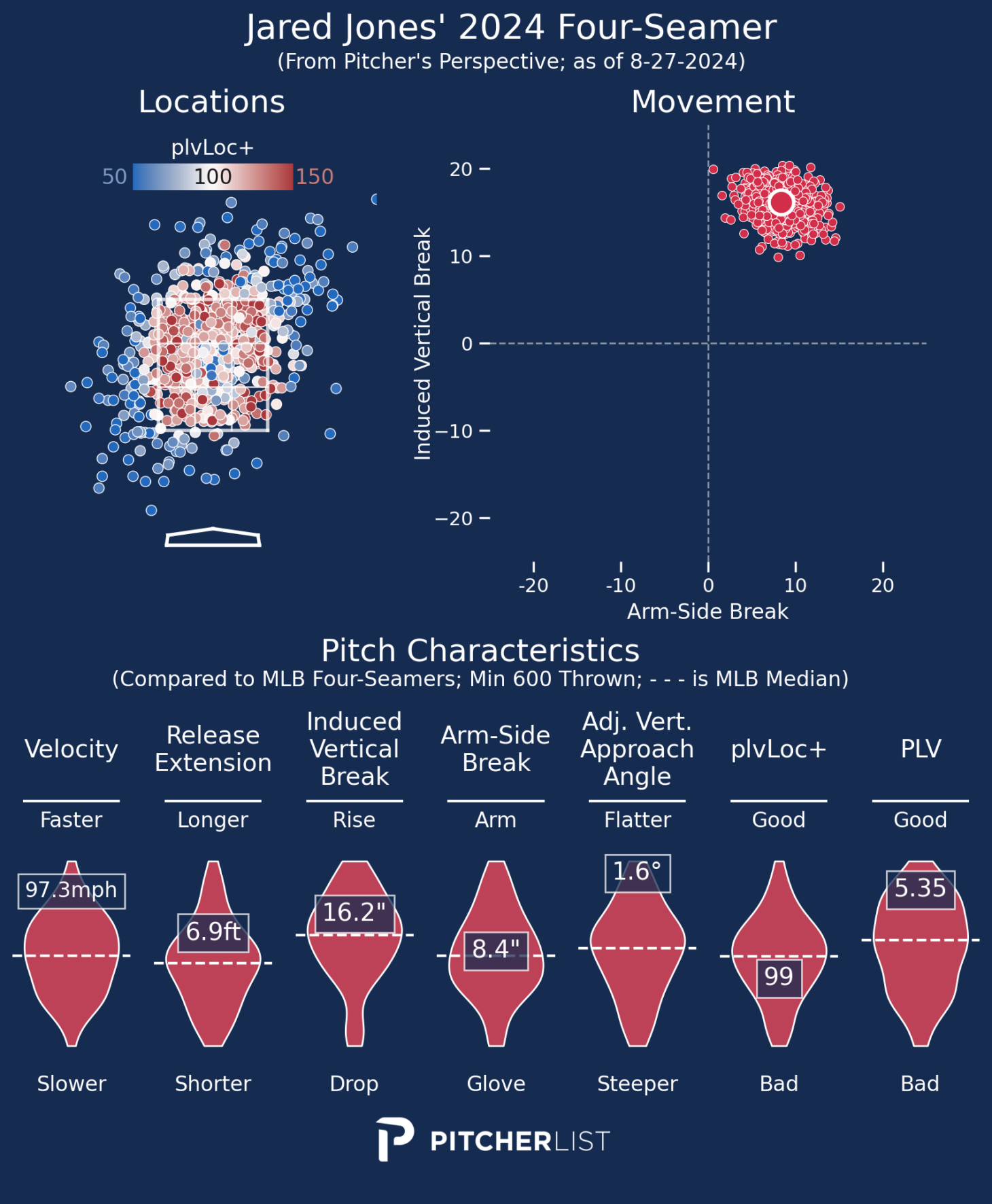We’re back with another week of the PLV report. This series will use the PLV metrics to contextualize player performance, and this week we’ll use our PLV model (Nick’s primer on PLV from last year can be found here) to analyze some of the best rookie pitching performances of the season. PLV allows us to dig into individual pitches as needed, or to analyze how a pitcher’s repertoire works holistically. When showing Pitch Type cards, there will also be a plvLocation+ score shown, which is modeled similarly to PLV, but only uses the end locations of the pitch (horizontal, vertical, and location within the specific hitter’s strike zone) as inputs.
Note: PLV metrics listed are current through Thursday, August 29th.
We start our rookie highlights with one of the biggest surprises of the season. Schwellenbach came from out of nowhere to not only claim a starting gig for the Braves, but he has absolutely earned his place there, with a 28.7% K-rate and an above-average ERA. PLV is a fan of almost all of his pitches, with most being plus or better.
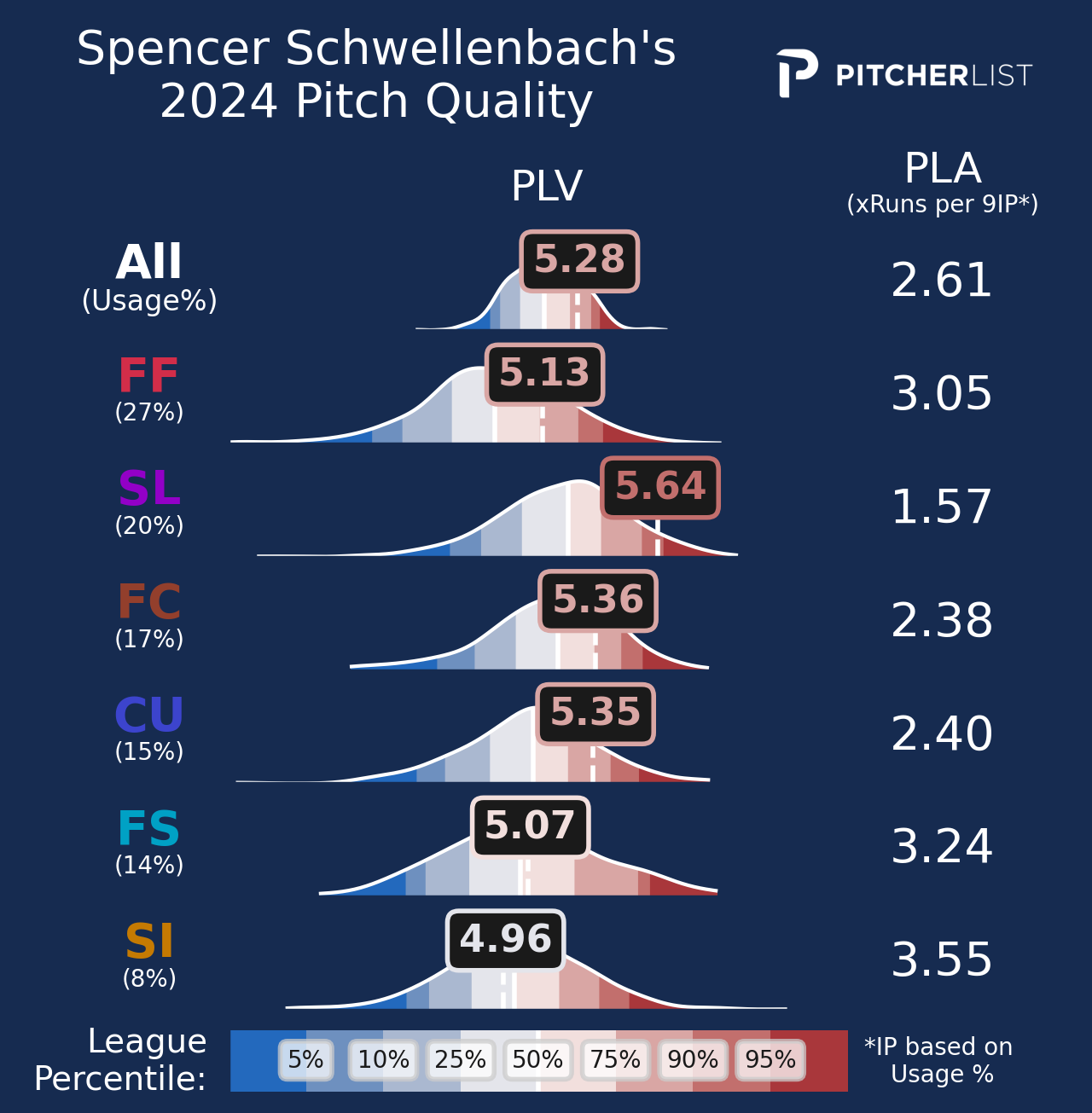
His repertoire covers a ton of area on a pitch movement plot, and includes a handful of distinct velo bands (mid-90s heat, a low 90s Cutter, a mid-80s Slider and Splitter, and a Curveball at 80). That’s a ton of looks to keep hitters off balance, especially when they’re all of good quality in their own right. This is a rookie who already has a crafty vet repertoire with matching skills and execution.
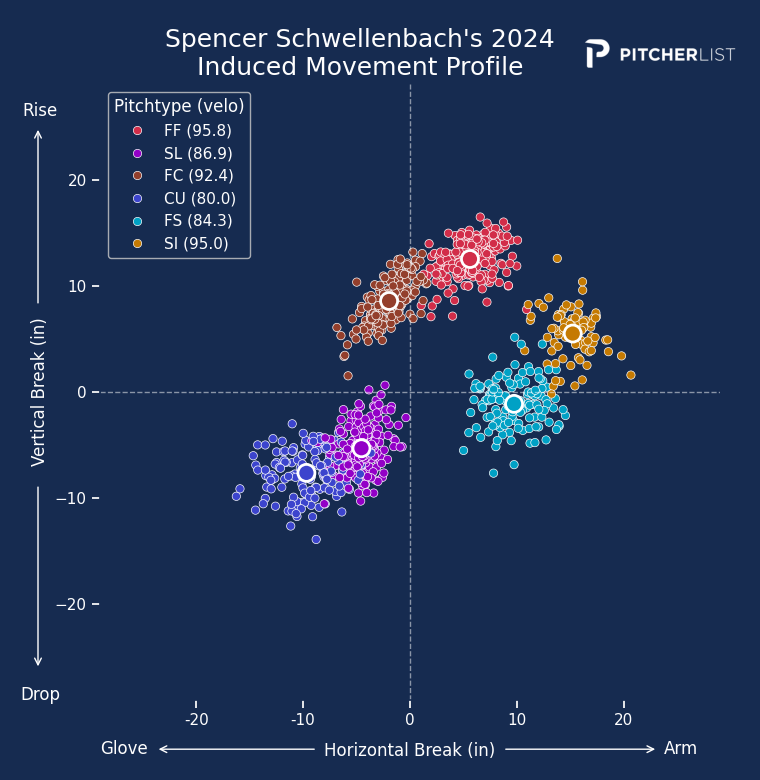
The pitch that makes everything work is his Slider. As Eno Sarris frequently says: this is a Slider league, and boy does Schwellenbach have a good one. 87 mph with nearly 7 ft of extension and 5 inches of drop, all great marks. That combination is how you return both an 18.2% SwStr rate (77th percentile) and a worm-killing 0.6-degree average launch angle (94th percentile), which earns a .272 xwOBAcon (85th percentile).
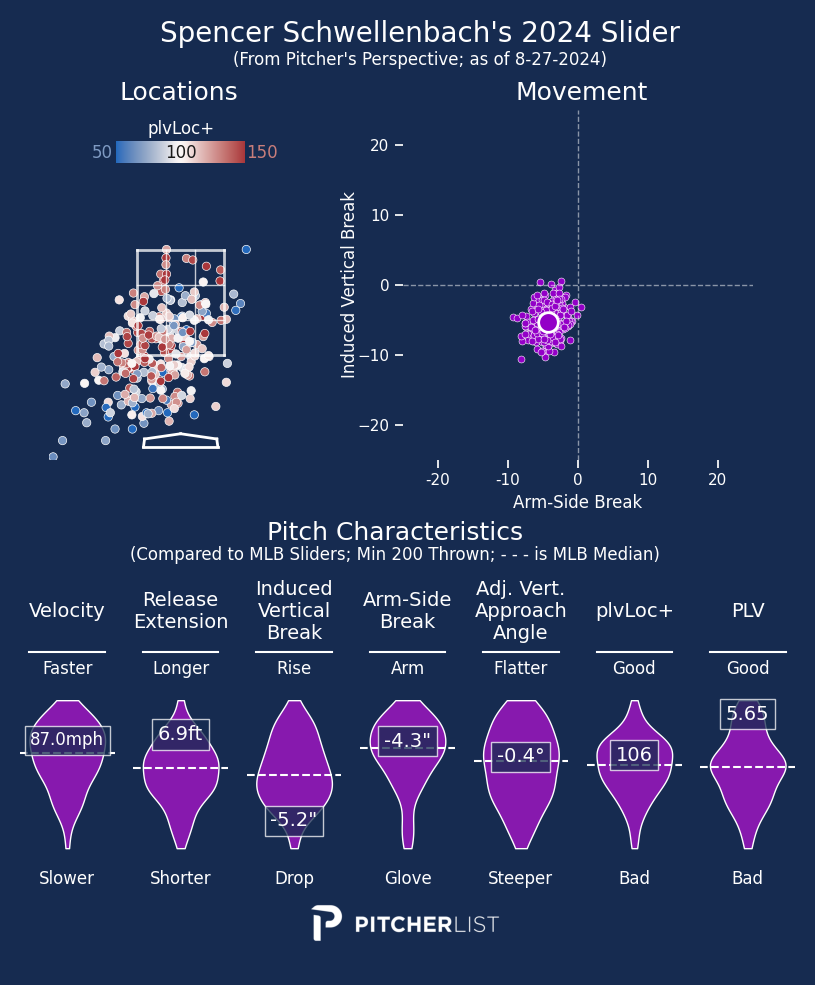
An article discussing rookie pitchers is invalid if Paul Skenes isn’t mentioned. Even his signs of regression (10 ER across his last 5 starts) aren’t that bad (they still returned a 3.18 ERA with a 29.5% K rate). He, too, has a number of movement profiles and velo bands to play with, from a much lower and less typical arm slot.
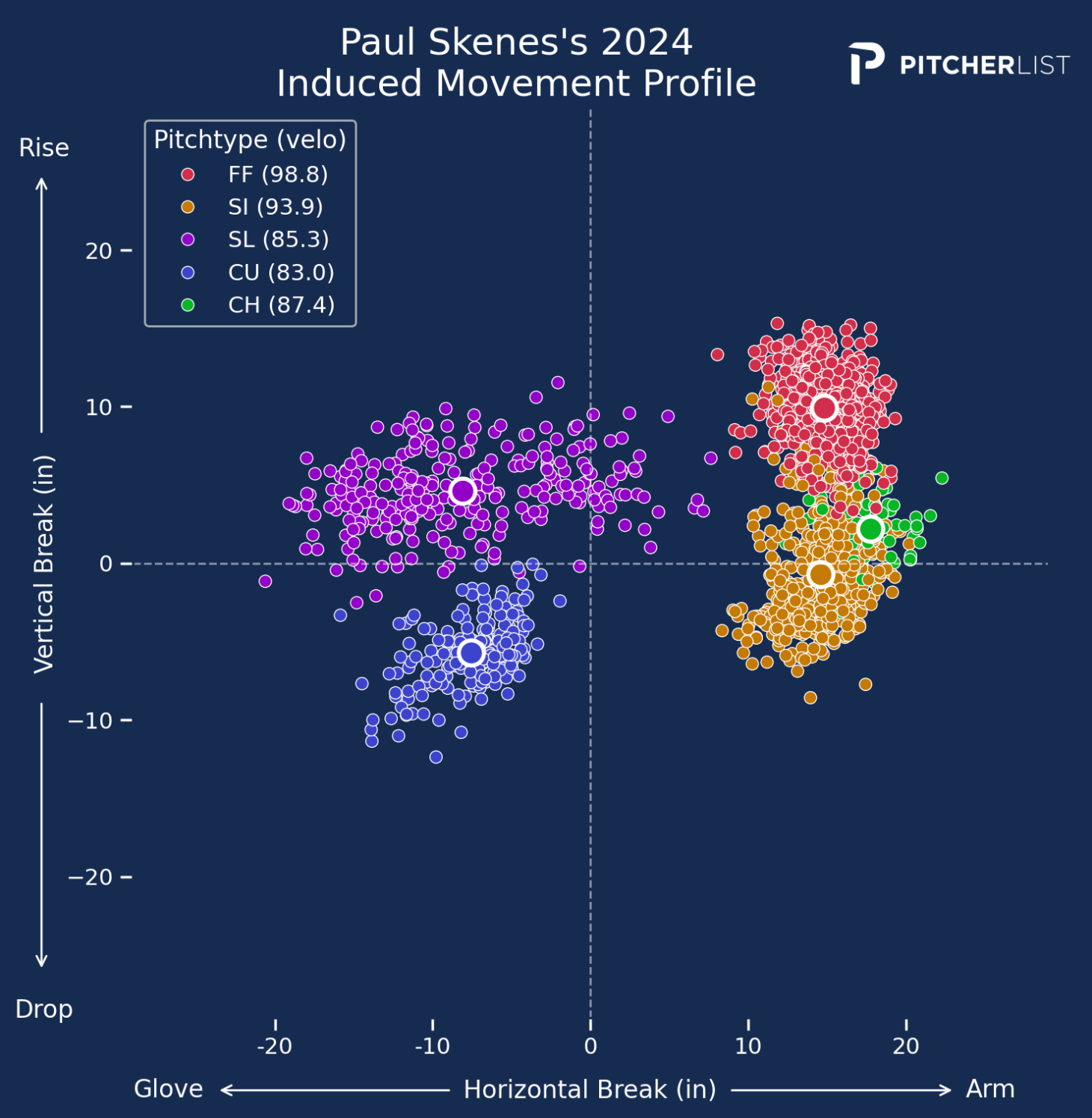
The pitch that helped him evolve from “elite prospect” to “elite starter” has to be his Sinker (née Splitter; aka Splinker). The pitch has been vexing both modeling systems (35 PitchingBot Overall grade & 82 Pitching+) and hitters (16.7% SwStr rate; 99th percentile). A recent addition to his career repertoire, the pitch is a true weapon for him. Sinkers usually don’t combine this level of velo (93.9 mph; 68th percentile) with this large of a velo difference from the primary fastball (5 mph slower from his 100th percentile 98.8 mph 4-Seamer). The pitch is truly one-of-one, and it is eating hitters up (despite poor locations!).
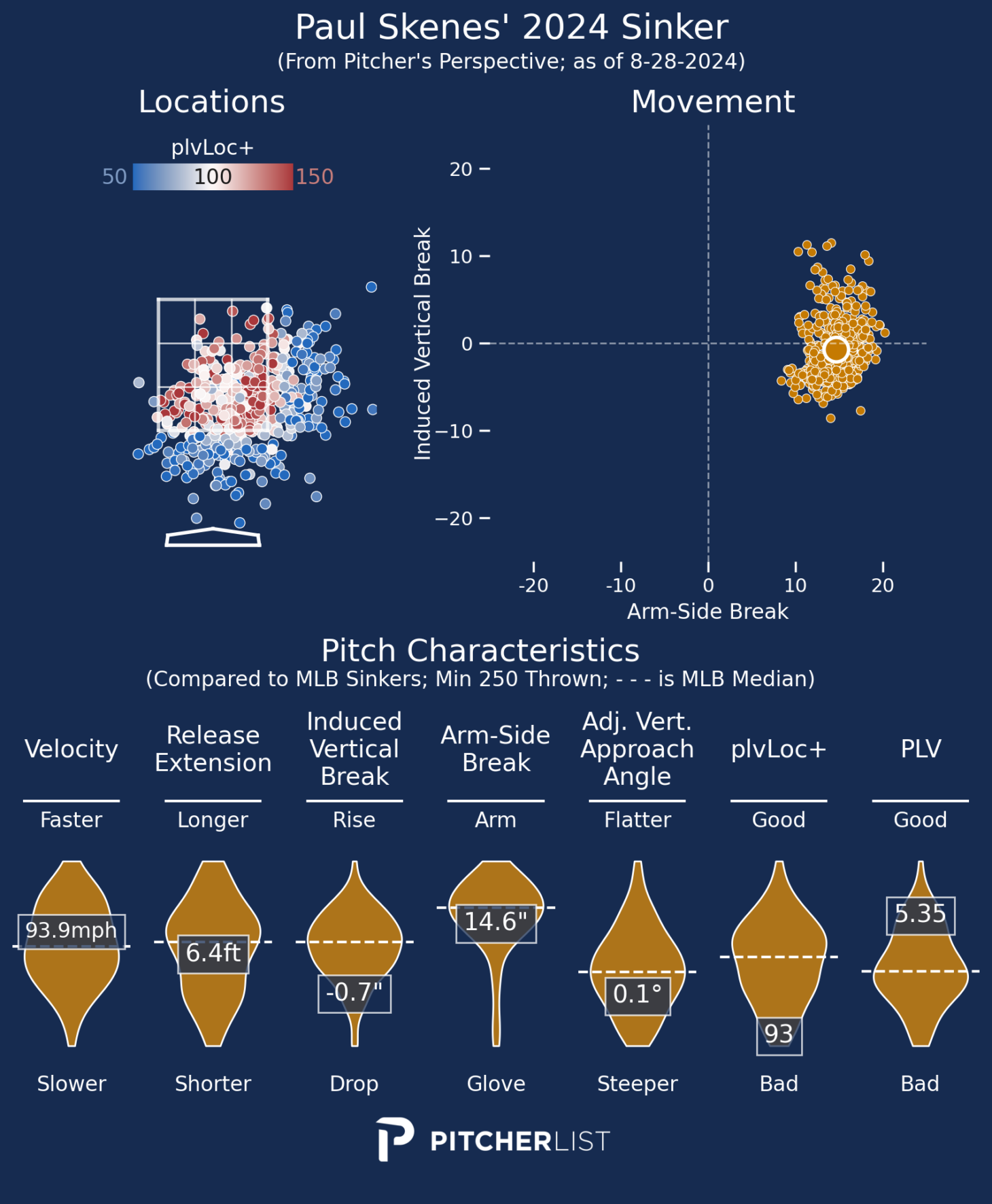
Festa is another breakout rookie pitcher. He was a solidly rated prospect (though not nearly at the level of Skenes) thanks to a starter’s mix of a mid-90s 4-Seamer and two hard secondaries (a mid 80’s gyro Slider and a high 80s Changeup), all of which he can command (50 current Command grade at Fangraphs, with a 55 future).

The Changeup has been the pitch that popped for him this season. It’s earned a 32.6% CSW (96th percentile!) and has a 5.39 PLV (90th percentile) thanks to its surprising rise (8.5″; 84th percentile), impressive velo (88.5 mph; 85th percentile) and elite locations (108 plvLocation+; 99th percentile). The locations are particularly impressive, as he does a great job of keeping the pitch arm-side (68.4% aLoc%; 90th percentile), so it really bears in on same-handed hitters and fades out of the zone against lefties.
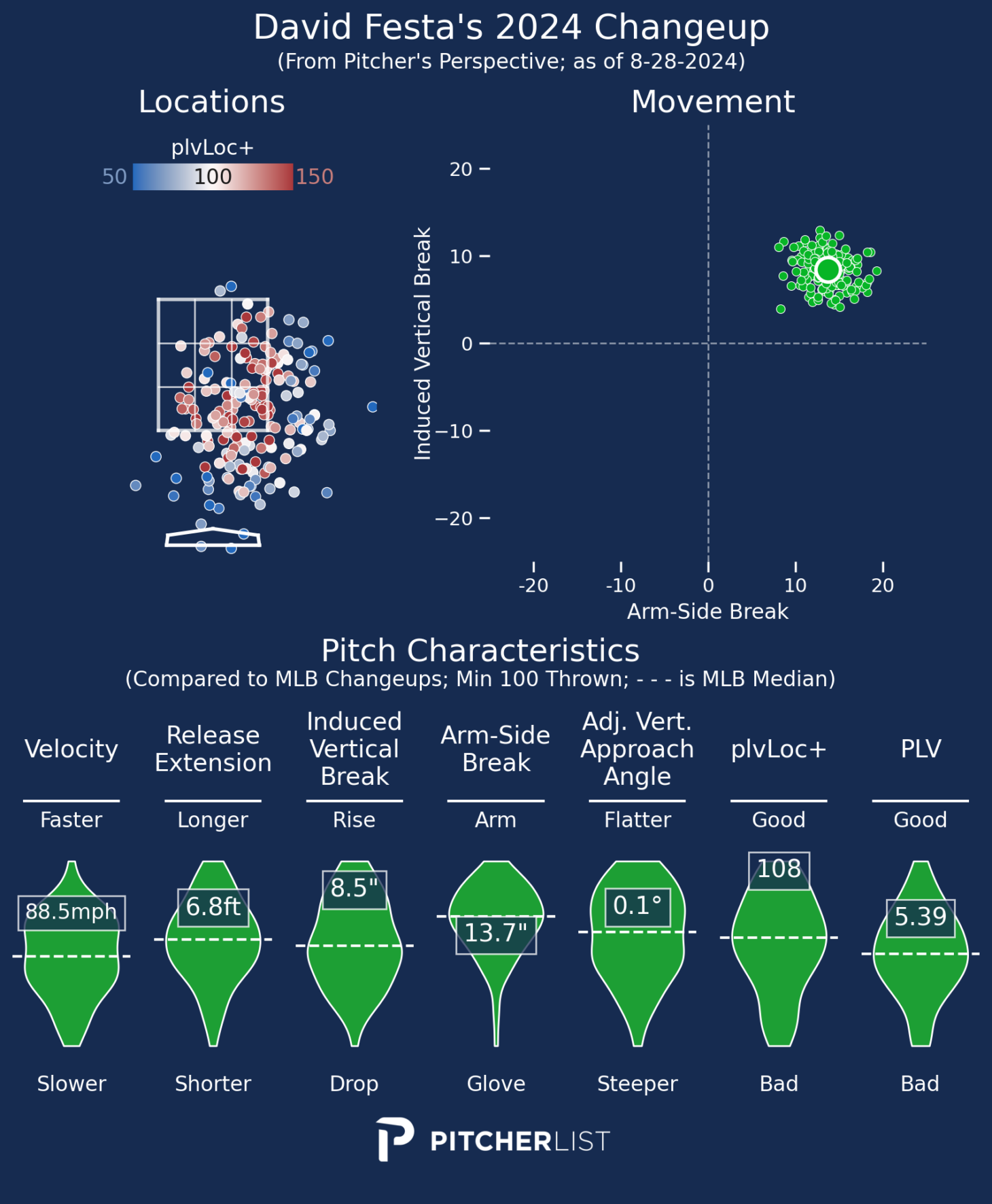
Luis Gil’s season has been a journey. He started the season well enough, but flipped a switch to “elite starter” in May, culminating in a 14-strikeout gem (in only 6 IP!) against the White Sox on May 18th. The problem is he has come back down to Earth since then (4.84 ERA since 6/1/24, with matching estimators). The main culprit is that his inability to locate (43.4% Zone rate; 19th percentile) has finally caught up with him (12.6% BB rate; 5th percentile). It’s not all doom and gloom: PLV is a believer in him, even with the control issues.

The reason PLV still believes is that his Stuff is outrageous. Remember when I said Festa’s Changeup has impressive velo? Well, Gil’s is 3 mph faster (91.7 mph; 99th percentile). His Slider has surprising rise (5.7″; 94th percentile) paired with great velo (87.9 mph; 86th percentile). The 4-Seam fastball is the lynchpin of his repertoire, thanks to elite velo (96.8 mph; 95th percentile), very good spin (2,426 RPM; 89th percentile), and good IVB (16.4″; 76th percentile) combined with a good attack angle (+1.2° Height Adjusted VAA; 78th percentile). That combination allows Gil’s 4-seam to remain competitive, even with terrible control (93 plvLocation+; 1st percentile).

Woods Richardson is essentially the anti-Luis Gil. All of his pitches are rated above-average by plvLocation+, which makes up for the distinctly not elite Stuff. The most impeccably located pitch in his mix is the Slider. A 111 plvLocation+ (97th percentile) allows him to maintain an average pitch, even though his movement profile isn’t quite a gyro Slider, while the velo (86.5 mph; 69th percentile) doesn’t quite make it a Cutter. That may ironically sound a lot like Gil’s Slider, but the 1.4 mph difference looms large from a Stuff point of view, and Gil’s Slider doesn’t actually grade out well (5.06 PLV; 29th percentile).
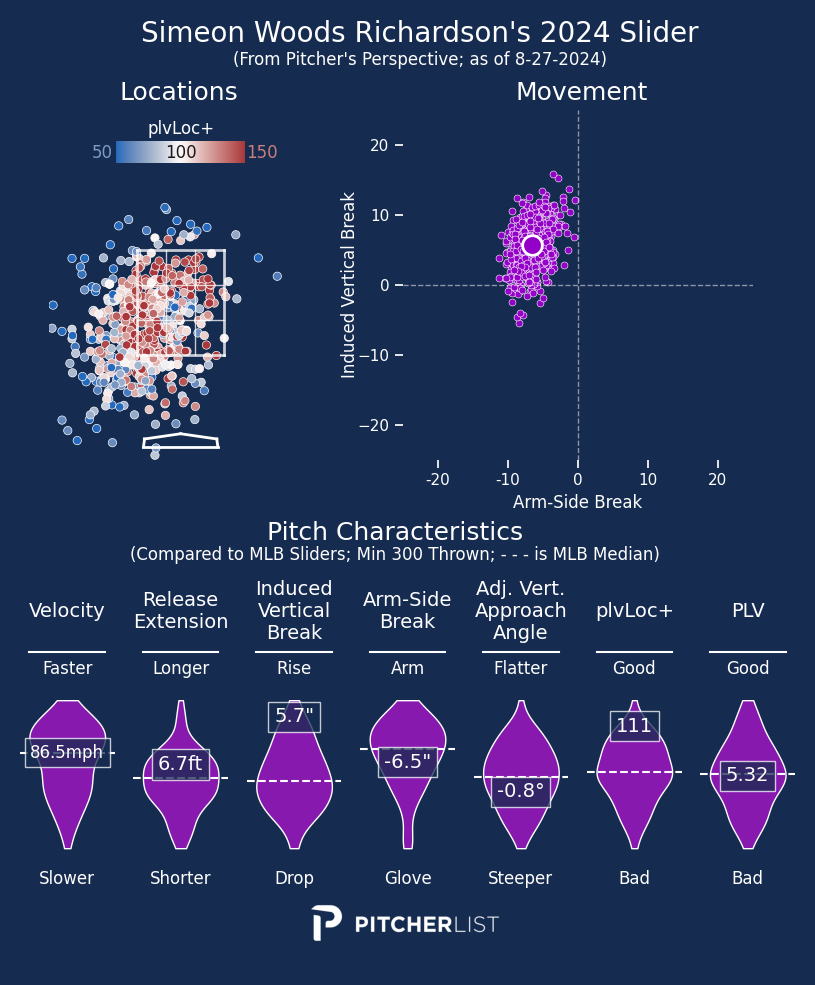
Similar story with his Curveball: The great locations (105 plvLocation+; 92nd percentile) paper over some Stuff weaknesses (75.9 mph velo; 15th percentile), yielding a useful pitch (5.10 PLV; 52nd percentile). Location values can be pretty noisy, but they give Woods Richardson a surprising upside.
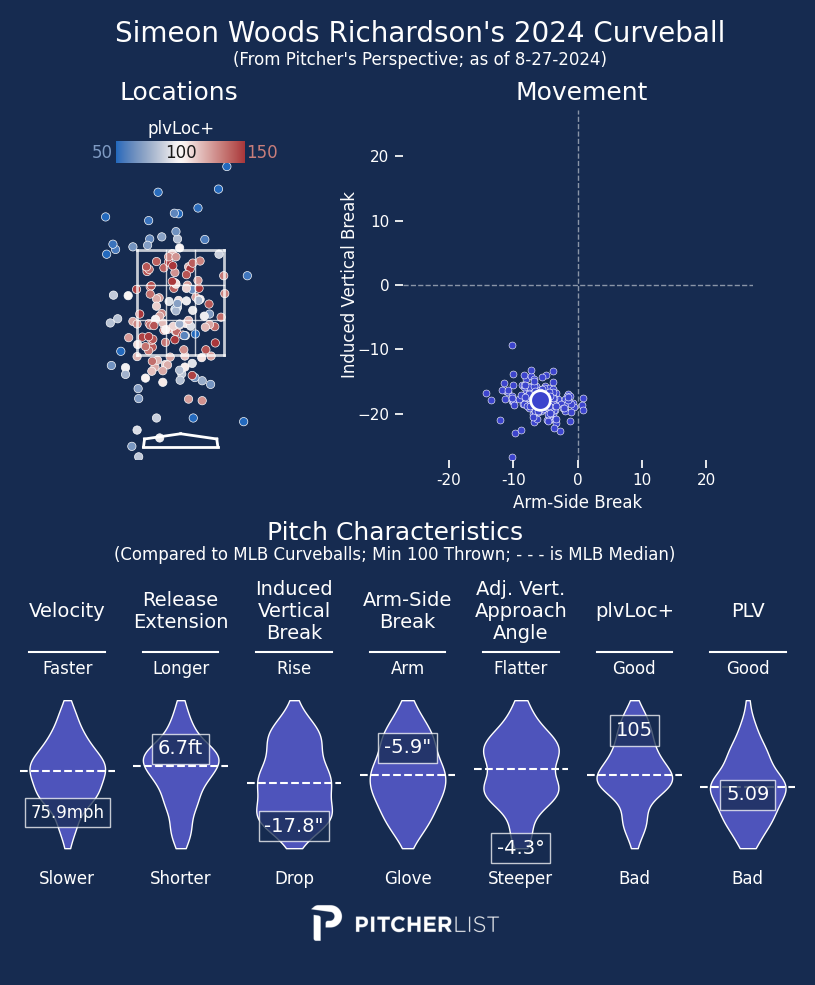
One of my favorite relievers from this season is Slaten. All of his pitches are just really, really good, with the Cutter being the best of the bunch. It functions almost like a turbo Slider, with its 4.7″ of glove-side break (82nd percentile) at 91.2 mph (74th percentile). That combination can play up with average locations, yielding above-average CSW% (30.4%; 64th percentile) and xwOBAcon (.295; 68th percentile).
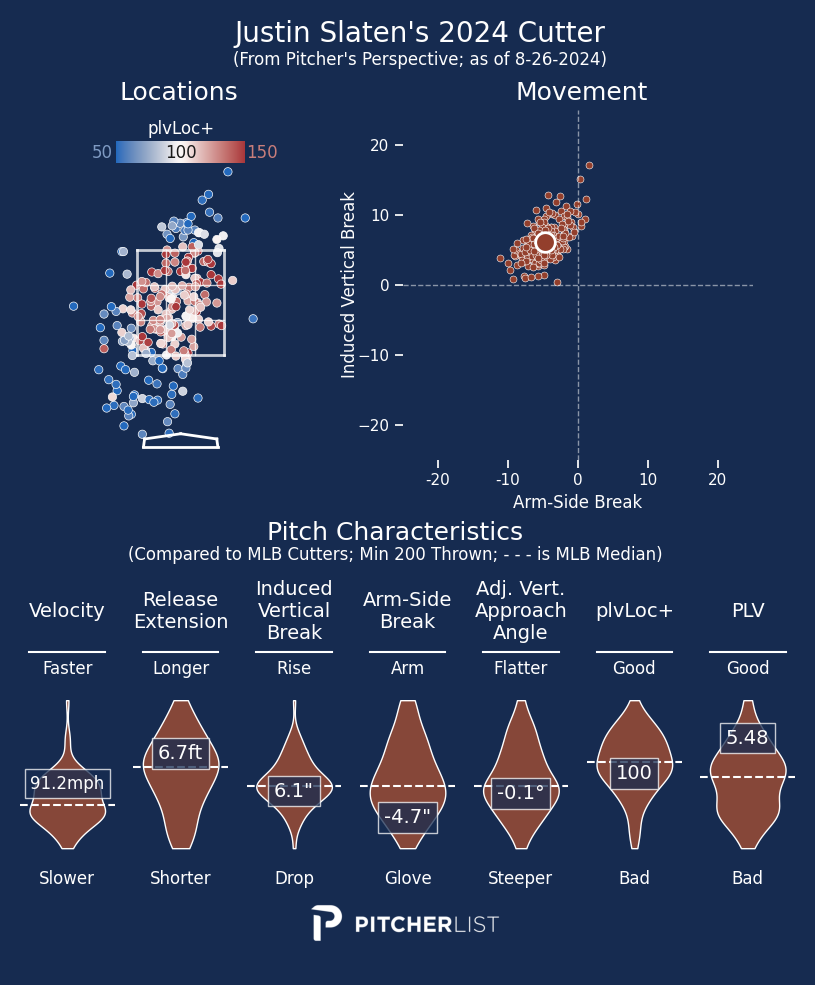
We’ll close with a guy whose results have tailed off pretty hard this season, but is still worth talking about. Jones still runs a decent Spencer Strider imitation, with a very good 4-Seamer/Slider pitch mix.
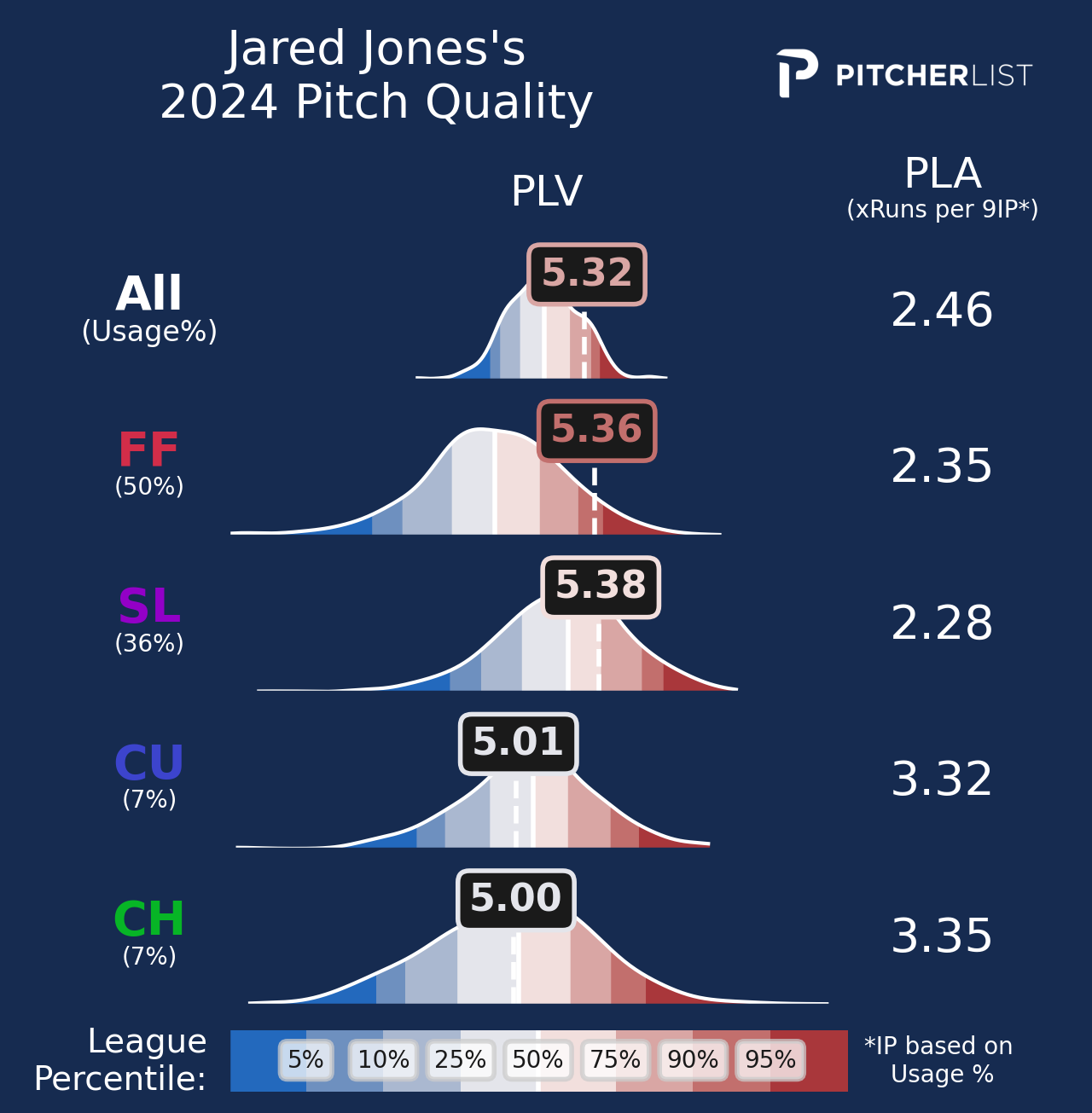
I really hope that people don’t forget about how great Jones has looked. The 4-Seamer, in particular, is wildly impressive. It has an elite +1.6° Height Adjusted VAA (97th percentile) with a similarly elite velo (97.3 mph; 97th percentile) and good vert (16.1″ IVB; 72nd percentile). That’s a recipe for whiffs, which is backed up by his 14.5% SwStr rate (94th percentile).
